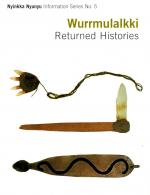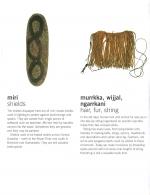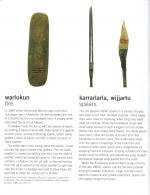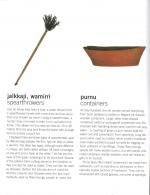Wurrmulalkki: Returned Histories (page 4)
jalkkaji, wamirri (spearthrowers)
Like an arrow fired from a bow, a spear thrown from a spearthrower travels with more force and accuracy than one thrown by hand. Using a spearthrower, a hunter does not need to run-up before his throw. This allows him to creep as close as 10 or 20 metres from his prey and throw the spear with enough force to ensure a quick kill. Displayed here are three types of spearthrower used by the Warumungu people the thin, flat one (top) is called a wamirri. The other two types, although quite different in shape, are both called jalkkaji. All have a handgrip at one end and a hook at the other. This fits into the base of the spear, enabling it to be launched. Several of the jalkkari have cutting stones in the handles so they can also be used as adzes. They can also be used as firesaws. Before the introduction of matches, firedrills (above) and firesaws were the two main methods used by Warumungu people to make fire.
purnu (containers)
As they travelled, the old people carried everything from bush potatoes to babies in elegant yet durable wooden containers. Large, often boat-shaped containers (wiitin or wulunganti) suspended over the shoulder with hairstring straps were used for carying water - a covering of grass or gum leaves kept the water cool and prevented it from splashing. Long flat purnu were used as cradles, while smaller hardwood ones made excellent scoops (yimpili) for digging up bush potatoes or sandfrogs. Today Warumungu people still make wooden purnu, but with plastic and metal containers readily avaliable most are made as gifts or for tourists. Purnu (also often called 'coolamons') are made from softwoods, such as beantree or stinkwood, or from naturally hollow sections of hardwood. They can be ornamented with carved grooves, red ochre or paintings.








